Robust Errorless-Control-Targeted Technique Based on MPC for Microgrid with Uncertain Electric Vehicle Energy Storage Systems
Abstract
:1. Introduction
- (1)
- The structure of the novel DCL control method is developed, with the details of each internal component presented. In comparison with the traditional droop control and VSG control strategies, droop controllers are not needed any longer, thereby avoiding the droop coefficients. As for the microgrids with uncertain EV energy storage systems, when the AC loads are heavy, the overall power provided by the EVs can be automatically determined by using the errorless-control-targeted scheme, and the maximum power that can be provided by each EV can be restrained by setting the maximum allowable discharge current.
- (2)
- After establishing a disturbance-based predicting plant model (PPM), the impacts of line resistance and inductance on the prediction accuracy of the FCS-MPC method are studied in the area of microgrid control, addressing the necessity of developing the robust MPC technique.
- (3)
- Sliding mode observers (SMO) based on the novel hyperbolic function are developed to detect the real-time disturbances which can be further used to generate voltage compensations by controlling them to maintain at zero. This is new in the area of microgrid control. In order to make the SMOs stable, Lyapunov functions are constructed to design the parameters of the observers. It deserves to be mentioned that the voltage compensations need to be substituted into the PPM to select the optimal voltage vector applied to the inverter, improving the prediction accuracy. By using the proposed SMO-based disturbance detection and compensation techniques, the MPC controller is endowed with strong robustness against parameter uncertainties.
2. Proposed Errorless-Control-Targeted DCL Strategy with Traditional MPC Controller
2.1. Structure of Proposed DCL Control Strategy
2.2. Details of Each Part of Proposed DCL Control Strategy
2.2.1. Real-Time Frequency, Phase Angle, and d, q-axis Voltage Detection
2.2.2. d, q-axis Current Calculation
2.2.3. Errorless Voltage and Frequency Control
2.2.4. Traditional MPC Control
2.2.5. Hardware System
- Firstly, being similar to the traditional V2G technology, whether an EV begins to feed or stops feeding the microgrid, is determined by the vehicle owners. This can be achieved by using an app installed on their phones [41]. Secondly, the EV energy storage system works when it is needed. In detail, if the energy provided by the distributed generation and inherent storage systems is not enough to maintain the frequency and magnitude of the AC voltage at the rated level, the EV storage system will start to feed the grid. This phenomenon usually occurs when the AC loads are heavy, which reflect in the real-time voltage frequency and magnitude. Otherwise, the EV energy storage system is inactive.
- When the EVs provide energy to the microgrid, it is impossible to expect each vehicle to deliver unlimited power for the sake of safety. However, if no effective strategies are given to limit the output power of each vehicle, the horrible phenomenon might occur due to the proposed automatic control scheme when the microgrid voltage and frequency variations are extremely large. To solve the problem, considering that the output voltage of an EV energy storage system equals the DC-bus voltage Udc, as long as the output current of each system can be confined within their safe limits (determined by each vehicle) the EVs can work safely in the V2G process. It deserves to be mentioned that the maximum allowable output current of each EV system needs to be provided by the vehicle designers or manufacturers.
3. Robust SMDO-Based MPC Method
3.1. Impacts of Parameter Uncertainties on MPC Controller
3.2. Disturbance Observation Based on Sliding Mode Theory
3.2.1. SMDO
3.2.2. Stability Analysis
3.3. Disturbance Impact Elimination-Based Voltage Compensation for MPC
- (a)
- Measurement: The three-phase currents ia,b,c and voltages ua,b,c are detected by using current and voltage sensors.
- (b)
- Frequency, phase angle, and voltage extraction: The measured phase voltages are used to extract the frequency f, phase angle φ, and d, q-axis voltages ud,q by using the PLL.
- (c)
- For the abc/dq transformation of current: The measured phase currents are transformed to the d, q-axis currents id,q relying on the detected phase angle φ.
- (d)
- Calculation of magnitude of voltage: Use (6) to calculate the magnitude of voltage
- (e)
- The d, q-axis disturbance observation: The proposed SMDOs are employed to detect the real-time disturbances fd,q.
- (f)
- Calculation of voltage compensations: Use the ADRs to calculate the voltage compensations cd,q according to fd,q.
- (g)
- Prediction: Use the modified PPM (31) to estimate the future current states for each candidate voltage vector u000, u100, u110, u010, u011, u001, and u101, and select the voltage vectors that can make the future current satisfy the constraint condition (13).
- (h)
- Evaluation: Substitute the seven predicted values satisfying (13) into the cost function, selecting the optimal control voltage and the corresponding switching states.
- (i)
- Actuation: Apply the optimum switching states to the DC/AC inverter.
4. Simulation Results
4.1. Validation of Proposed DCL Method without Parameter Mismatch and EV Uncertainties Considered
4.2. Validation of Proposed DCL Method with EV Uncertainties Considered
4.3. Validation of Proposed DCL Method with Parameter Mismatch Considered
4.3.1. Lf_mea = 0.2Lf, Ll_mea = 0.2Ll, Rf_mea = 2Rf, Rl_mea = 2Rl
4.3.2. Lf_mea = 2Lf, Ll_mea = 1.5Ll, Rf_mea = 0.5Rf, Rl_mea = 0.3Rl
5. Conclusions
- (1)
- A novel DCL control method is proposed, with each part of it detailed. In comparison with the traditional control strategies, such as droop control and VSG control, the proposed one aims to directly regulate the frequency, voltage, and currents rather than the power of the system. As for this strategy, droop coefficients are no longer needed, solving the problem that it is difficult to determine the droop coefficients of the microgrid with uncertain EV energy storage systems.
- (2)
- The impacts of the system parameter mismatch on the prediction accuracy of the FCS-MPC are analyzed explicitly, posing the necessity of developing the robust MPC controller.
- (3)
- SMDOs based on the hyperbolic function are developed to detect the d, q-axis disturbances, with their stability discussed innovatively. The detected disturbances are controlled to maintain at zero by using ADRs, generating voltage compensations used for modifying the PPM of the MPC controller, thus achieving the goal of disturbance impact elimination. Simulation results prove that the proposed strategies are effective.
Author Contributions
Funding
Institutional Review Board Statement
Informed Consent Statement
Conflicts of Interest
Nomenclature
| n | Number of charging piles in one microgrid |
| c | Ratio of EVs working at V2G mode to the maximum number of EVs |
| tsu, t | Period of EVs working at V2G mode, time |
| Psu | Supporting power from EVs |
| ua,b,c, ia,b,c | Three-phase voltages and currents |
| Udc | Bus voltage |
| T1, T2, …, T6 | Transistors |
| D1, D2, …, D6 | Diodes |
| Rf, Lf, Cf, Rl, Ll | Filter and line resistances, inductances and capacitance |
| Rf_mea, Lf_mea, Rl_mea, Ll_mea | Measured filter and line resistances and inductances |
| ∆Rf, ∆Lf, ∆Rl, ∆Ll | Deviations of filter and line resistances and inductances |
| ea, eb, ec | Output voltage of the inverter |
| ed, eq | d, q-axis control voltages |
| ud, uq | d, q-axis voltages |
| id, iq | d, q-axis currents |
| id*, iq* | d, q-axis current references |
| u* | Voltage reference |
| φ | Phase angle |
| Frequency and voltage magnitude | |
| Pt, Pe, Q | Mechanical power and active power, reactive power in VSG control |
| ω, ωN, PN, QN, VN, fN | Angular frequency, nominal speed, power, voltage and frequency |
| kw, kv | Droop coefficients for frequency and voltage in VSG control |
| θ, V | Angle and voltage amplitude for control |
| J | Virtual inertia for VSG control |
| D | Virtual damping for VSG control |
| fd, fq | d, q-axis disturbances |
| cd, cq | d, q-axis voltage compensations |
| kF_p, kF_i | Proportional and integral factors for AFR |
| kV_p, kV_i | Proportional and integral factors for AVR |
| kd, kq | Gain factors of sliding mode observers |
| , | Estimated currents of SMDOs |
| , | Errors between estimated currents and real currents in SMDOs |
| Ts | Control period |
| m | Boundary-layer constant |
| S | Sliding mode surfaces |
| Ly | Lyapunov function |
| λ | The smallest allowable estimation error |
| imax | The maximum allowable current of the system |
References
- Wang, T.; O’Neill, D.; Kamath, H. Dynamic Control and Optimization of Distributed Energy Resources in a Microgrid. IEEE Trans. Smart Grid 2015, 6, 2884–2894. [Google Scholar] [CrossRef] [Green Version]
- Benhalima, S.; Miloud, R.; Chandra, A. Real-Time Implementation of Robust Control Strategies Based on Sliding Mode Control for Standalone Microgrids Supplying Non-Linear Loads. Energies 2018, 11, 2590. [Google Scholar] [CrossRef] [Green Version]
- Mueller, J.A.; Kimball, J.W. An Efficient Method of Determining Operating Points of Droop-Controlled Microgrids. IEEE Trans. Energy Convers. 2017, 32, 1432–1446. [Google Scholar] [CrossRef]
- Camacho, A.; Castilla, M.; Canziani, F.; Moreira, C.; Coelho, P.; Gomes, M.; Mercado, P.E. Performance Comparison of Grid-Faulty Control Schemes for Inverter-Based Industrial Microgrids. Energies 2017, 10, 2096. [Google Scholar] [CrossRef] [Green Version]
- Liu, C.; Chau, K.T.; Wu, D.; Gao, S. Opportunities and Challenges of Vehicle-to-Home, Vehicle-to-Vehicle, and Vehicle-to-Grid Technologies. Proc. IEEE 2013, 101, 2409–2427. [Google Scholar] [CrossRef] [Green Version]
- Ouramdane, O.; Elbouchikhi, E.; Amirat, Y.; Sedgh Gooya, E. Optimal Sizing and Energy Management of Microgrids with Vehicle-to-Grid Technology: A Critical Review and Future Trends. Energies 2021, 14, 4166. [Google Scholar] [CrossRef]
- Shuai, Z.; Mo, S.; Wang, J.; Shen, Z.J.; Tian, W.; Feng, Y. Droop control method for load share and voltage regulation in high-voltage microgrids. J. Mod. Power Syst. Clean Energy 2016, 4, 76–86. [Google Scholar] [CrossRef] [Green Version]
- Beck, H.P.; Hesse, R. Virtual Synchronous Machine. In Proceedings of the International Conference on Electrical Power Quality & Utilisation, Barcelona, Spain, 9–11 October 2007; pp. 1–6. [Google Scholar]
- Zhao, Y.; Guo, L. Dynamical Simulation of Laboratory MicroGrid. In Proceedings of the IEEE 2009 Asia-Pacific Power and Energy Engineering Conference (APPEEC), Wuhan, China, 28–30 March 2009; pp. 1–5. [Google Scholar]
- Deng, Y.; Tao, Y.; Chen, G.; Li, G.; He, X. Enhanced Power Flow Control for Grid-Connected Droop-Controlled Inverters with Improved Stability. IEEE Trans. Ind. Electron. 2017, 64, 5919–5929. [Google Scholar] [CrossRef]
- Ashabani, M.; Ibrahim-Mohamed, Y.; Mirsalim, M.; Aghashabani, M. Multivariable Droop Control of Synchronous Current Converters in Weak Grids/Microgrids with Decoupled dq-Axes Currents. IEEE Trans. Smart Grid 2015, 6, 1610–1620. [Google Scholar] [CrossRef]
- Gorijeevaram Reddy, P.K.; Dasarathan, S.; Krishnasamy, V. Investigation of Adaptive Droop Control Applied to Low-Voltage DC Microgrid. Energies 2021, 14, 5356. [Google Scholar] [CrossRef]
- Li, G.; Ma, F.; Luo, A.; He, Z.; Wu, W.; Wei, X.; Zhu, Z.; Guo, J. Virtual impedance-based virtual synchronous generator control for grid-connected inverter under the weak grid situations. IET Power Electron. 2018, 11, 2125–2132. [Google Scholar] [CrossRef]
- Wu, W.; Chen, Y.; Zhou, L.; Luo, A.; Zhou, X.; He, Z.; Yang, L.; Xie, Z.; Liu, J.; Zhang, M. Sequence Impedance Modeling and Stability Comparative Analysis of Voltage-Controlled VSGs and Current-Controlled VSGs. IEEE Trans. Ind. Electron. 2018, 66, 6460–6472. [Google Scholar] [CrossRef]
- Zhong, Q.; Weiss, G. Synchronverters: Inverters That Mimic Synchronous Generators. IEEE Trans. Ind. Electron. 2011, 58, 1259–1267. [Google Scholar] [CrossRef]
- Jin, N.; Pan, C.; Li, Y.; Hu, S.; Fang, J. Model Predictive Control for Virtual Synchronous Generator with Improved Vector Selection and Reconstructed Current. Energies 2020, 13, 5435. [Google Scholar] [CrossRef]
- Magdy, G.; Bakeer, A.; Nour, M.; Petlenkov, E. A New Virtual Synchronous Generator Design Based on the SMES System for Frequency Stability of Low-Inertia Power Grids. Energies 2020, 13, 5641. [Google Scholar] [CrossRef]
- Mo, O.; D’Arco, S.; Suul, J.A. Evaluation of Virtual Synchronous Machines with Dynamic or Quasi-Stationary Machine Models. IEEE Tran. Ind. Electron. 2017, 64, 5952–5962. [Google Scholar] [CrossRef] [Green Version]
- D’Arco, S.; Suul, J.A. Equivalence of Virtual Synchronous Machines and Frequency-Droops for Converter-Based MicroGrids. IEEE Trans. Smart Grid 2014, 5, 394–395. [Google Scholar] [CrossRef]
- Li, B.; Li, Q.; Wang, Y.; Wen, W.; Li, B.; Xu, L. A Novel Method to Determine Droop Coefficients of DC Voltage Control for VSC-MTDC System. IEEE Trans. Power Deliv. 2020, 35, 2196–2211. [Google Scholar] [CrossRef]
- Pavan Kumar, Y.V.; Bhimasingu, R. Modern Control Methods for Adaptive Droop Coefficients’ Design. In Microgrid: Operation, Control, Monitoring and Protection; Springer: Singapore, 2020; pp. 111–148. [Google Scholar]
- Saleh-Ahmadi, A.; Moattari, M.; Gahedi, A.; Pouresmaeil, E. Droop Method Development for Microgrids Control Considering Higher Order Sliding Mode Control Approach and Feeder Impedance Variation. Appl. Sci. 2021, 11, 967. [Google Scholar] [CrossRef]
- Yogarathinam, A.; Chaudhuri, N.R. Stability-Constrained Adaptive Droop for Power Sharing in AC-MTDC Grids. IEEE Trans. Power Syst. 2019, 34, 1955–1965. [Google Scholar] [CrossRef]
- Wang, R.; Chen, L.; Zheng, T.; Mei, S. VSG-based adaptive droop control for frequency and active power regulation in the MTDC system. CSEE J. Power Energy Syst. 2017, 3, 260–268. [Google Scholar] [CrossRef]
- Baudoin, S.; Vechiu, I.; Camblong, H. A review of voltage and frequency control strategies for islanded microgrid. In Proceedings of the 2012 16th International Conference on System Theory, Control and Computing (ICSTCC), Sinaia, Romania, 12–14 October 2012; pp. 1–5. [Google Scholar]
- Kos, T.; Huba, M.; Vrančić, D. Parametric and Nonparametric PI Controller Tuning Method for Integrating Processes Based on Magnitude Optimum. Appl. Sci. 2020, 10, 1443. [Google Scholar] [CrossRef] [Green Version]
- Leal, I.S.; Abeykoon, C.; Perera, Y.S. Design, Simulation, Analysis and Optimization of PID and Fuzzy Based Control Systems for a Quadcopter. Electronics 2021, 10, 2218. [Google Scholar] [CrossRef]
- Simmini, F.; Caldognetto, T.; Bruschetta, M.; Mion, E.; Carli, R. Model Predictive Control for Efficient Management of Energy Resources in Smart Buildings. Energies 2021, 14, 5592. [Google Scholar] [CrossRef]
- Elsisi, M.; Abeoelela, M.; Soliman, M.; Mansor, W. Design of Optimal Model Predictive Controller for LFC of Nonlinear Multi-area Power System with Energy Storage Devices. Electr. Power Compon. Syst. 2018, 46, 1300–1311. [Google Scholar] [CrossRef]
- Valverde, L.; Bordons, C.; Rosa, F. Power Management using Model Predictive Control in a Hydrogen-based Microgrid. In Proceedings of the IECON 2012—38th Annual Conference on IEEE Industrial Electronics Society, Montreal, QC, Canada, 25–28 October 2012; pp. 5669–5676. [Google Scholar]
- Elsisi, M. New Variable Structure Control based on Different Meta-Heuristics Algorithms for Frequency Regulation Considering Nonlinearities Effects. Intern. Trans. Electr. Energy Syst. 2020, 30, 12428. [Google Scholar] [CrossRef]
- Elsisi, M.; Soliman, M.; Aboelela, M.A.S.; Mansour, W. GSA-Based Design of Dual Proportional Integral Load Frequency Controllers for Nonlinear Hydrothermal Power System. World Acad. Sci. Eng. Technol. 2015, 9, 1–7. [Google Scholar]
- Elsisi, M. Future Search Algorithm for Optimization. Evol. Intell. 2019, 12, 21–31. [Google Scholar] [CrossRef]
- Han, Y.; Gong, C.; Yan, L.; Wen, H.; Wang, Y.; Shen, K. Multiobjective Finite Control Set Model Predictive Control Using Novel Delay Compensation Technique for PMSM. IEEE Trans. Power Electron. 2020, 35, 11193–11204. [Google Scholar] [CrossRef]
- Valibeygi, A.; Habib, A.H.; de Callafon, R.A. Robust Power Scheduling for Microgrids with Uncertainty in Renewable Energy Generation. In Proceedings of the 2019 IEEE Power & Energy Society Innovative Smart Grid Technologies Conference (ISGT), Gramado, Brazil, 18–21 February 2019; pp. 1–5. [Google Scholar]
- Davari, M.; Mohamed, Y.A.I. Robust Multi-Objective Control of VSC-Based DC-Voltage Power Port in Hybrid AC/DC Multi-Terminal Micro-Grids. IEEE Trans. Smart Grid 2013, 4, 1597–1612. [Google Scholar] [CrossRef]
- Aryani, D.R.; Song, H. Coordination Control Strategy for AC/DC Hybrid Microgrids in Stand-Alone Mode. Energies 2016, 9, 469. [Google Scholar] [CrossRef]
- Shi, X.; Lan, T.; Hu, J.P. PID controller tuning using optimization based on gradient-immune algorithm. In Proceedings of the 2012 International Symposium on Instrumentation & Measurement, Sensor Network and Automation (IMSNA), Sanya, China, 25–28 August 2012; pp. 173–175. [Google Scholar]
- Gao, J.; Gong, C.; Li, W.; Liu, J. Novel Compensation Strategy for Calculation Delay of Finite Control Set Model Predictive Current Control in PMSM. IEEE Trans. Ind. Electron. 2019, 67, 5816–5819. [Google Scholar] [CrossRef]
- Hennane, Y.; Berdai, A.; Martin, J.-P.; Pierfederici, S.; Meibody-Tabar, F. New Decentralized Control of Mesh AC Microgrids: Study, Stability, and Robustness Analysis. Sustainability 2021, 13, 2243. [Google Scholar] [CrossRef]
- Krueger, H.; Cruden, A. Integration of electric vehicle user charging preferences into Vehicle-to-Grid aggregator controls. Energy Rep. 2020, 6, 86–95. [Google Scholar] [CrossRef]
- Gong, C.; Hu, Y.; Gao, J.; Wang, Y.; Yan, L. An Improved Delay-Suppressed Sliding-Mode Observer for Sensorless Vector-Controlled PMSM. IEEE Trans. Ind. Electron. 2020, 67, 5913–5923. [Google Scholar] [CrossRef]
- Liang, Y.; He, Y.; Niu, Y. Microgrid Frequency Fluctuation Attenuation Using Improved Fuzzy Adaptive Damping-Based VSG Considering Dynamics and Allowable Deviation. Energies 2020, 13, 4885. [Google Scholar] [CrossRef]
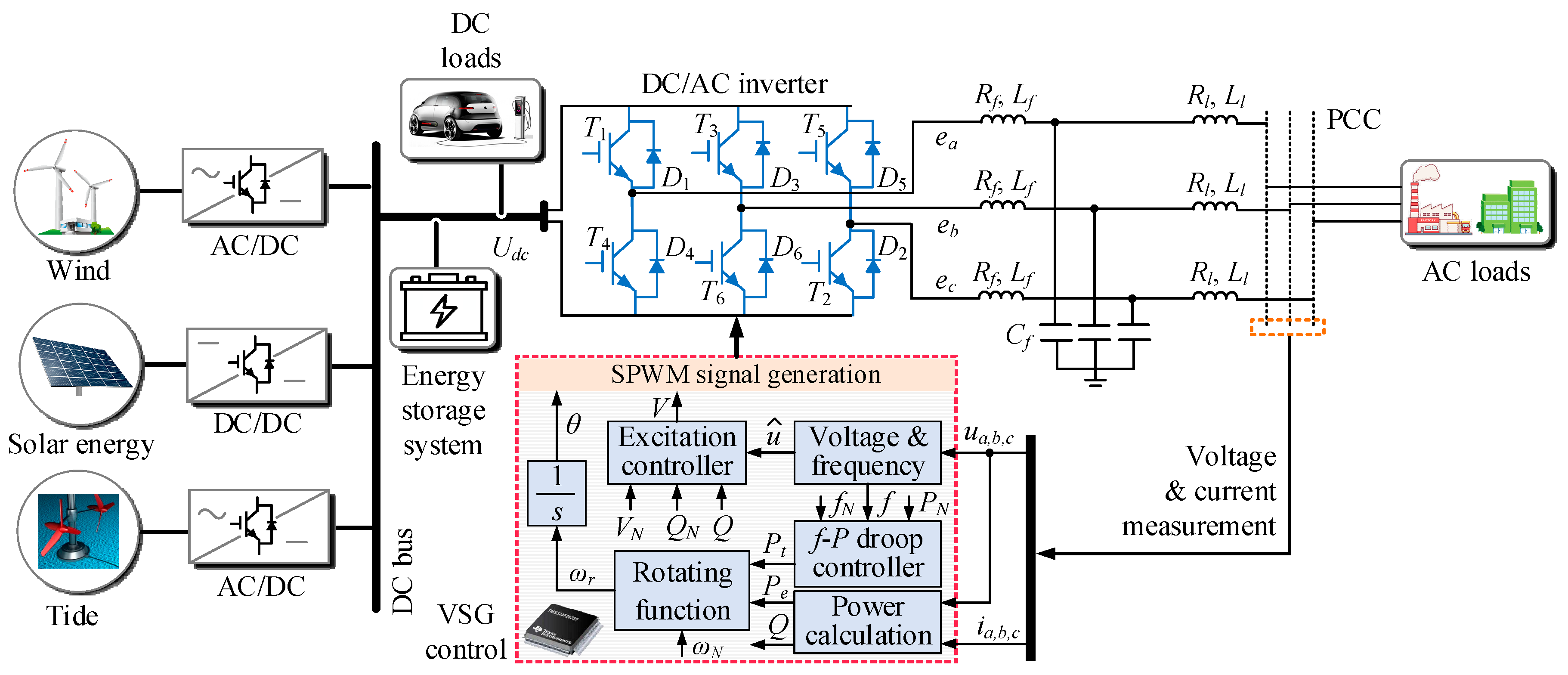

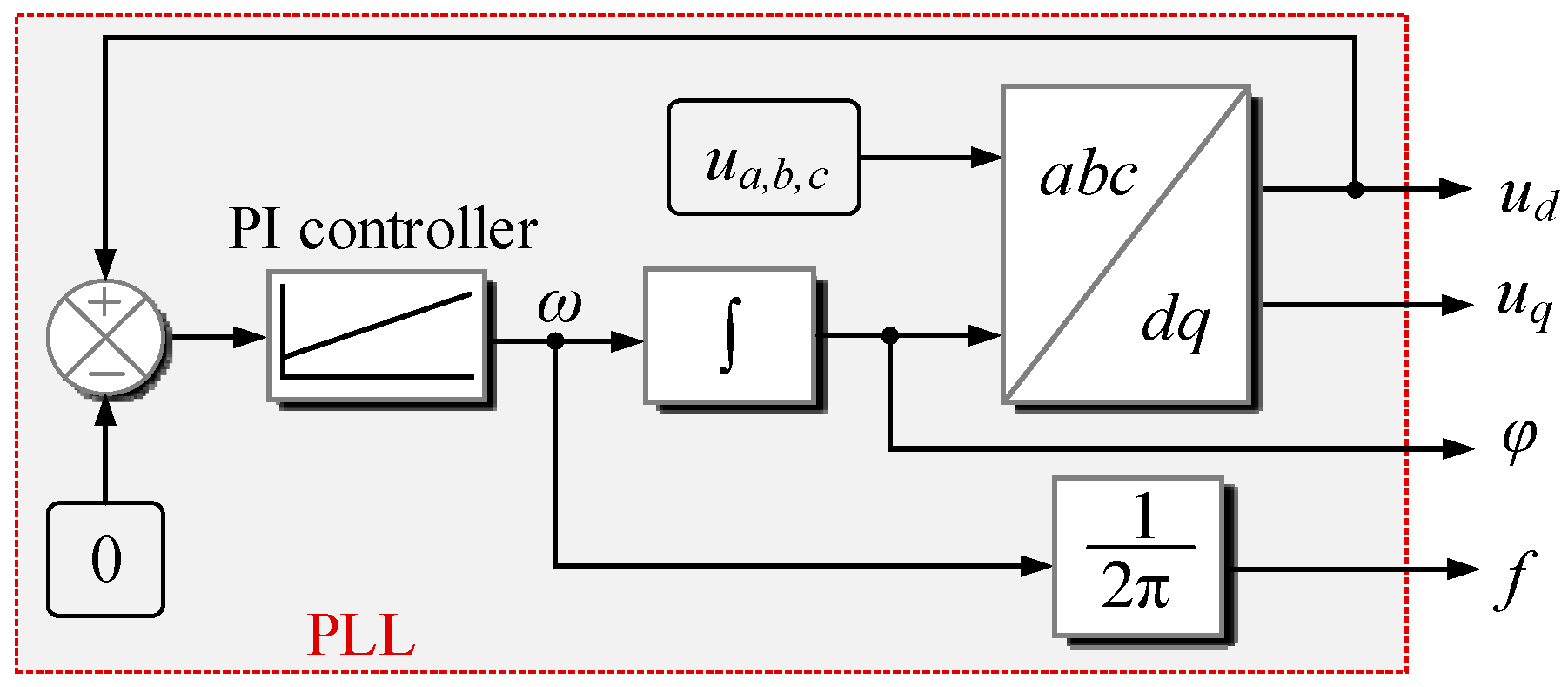

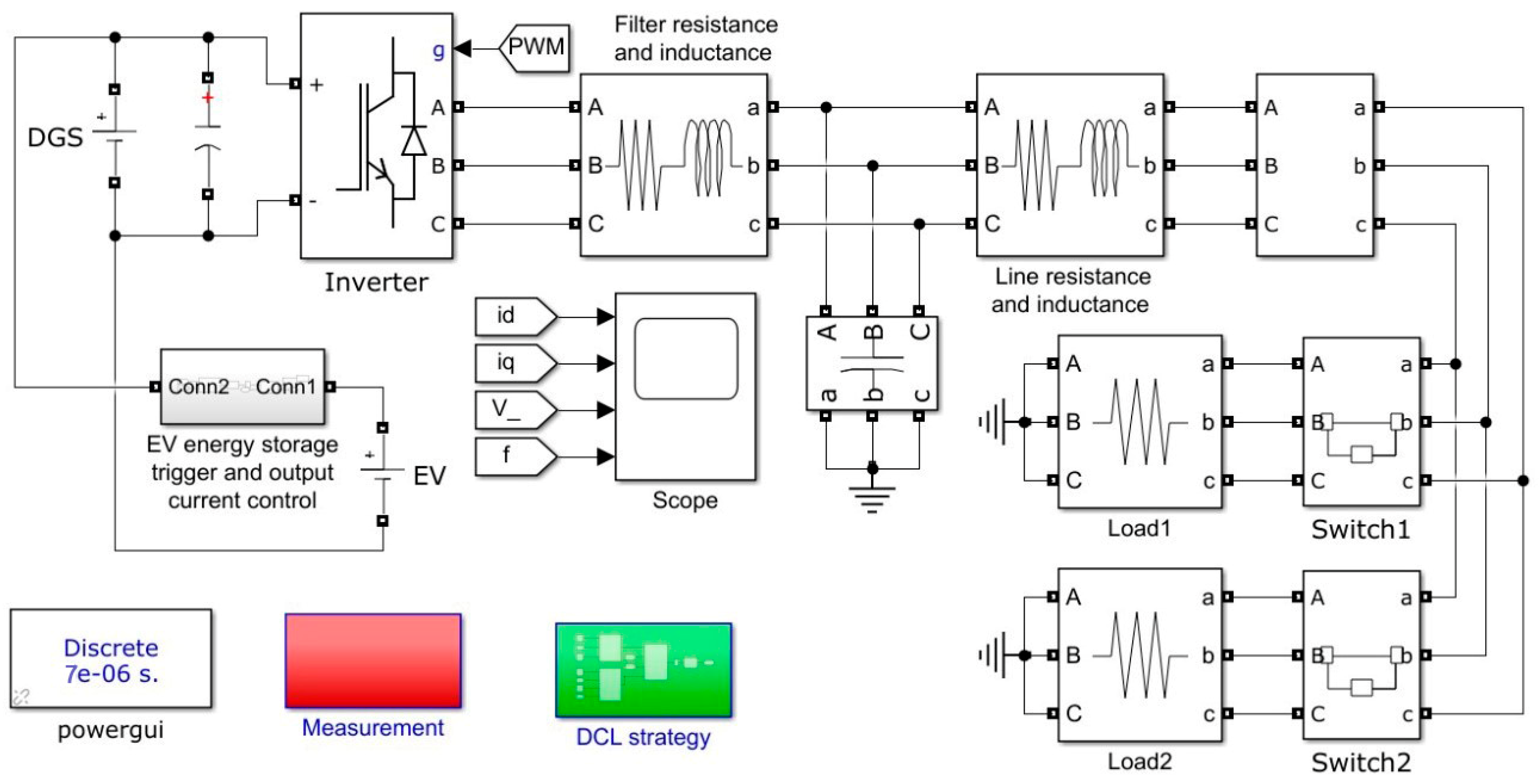

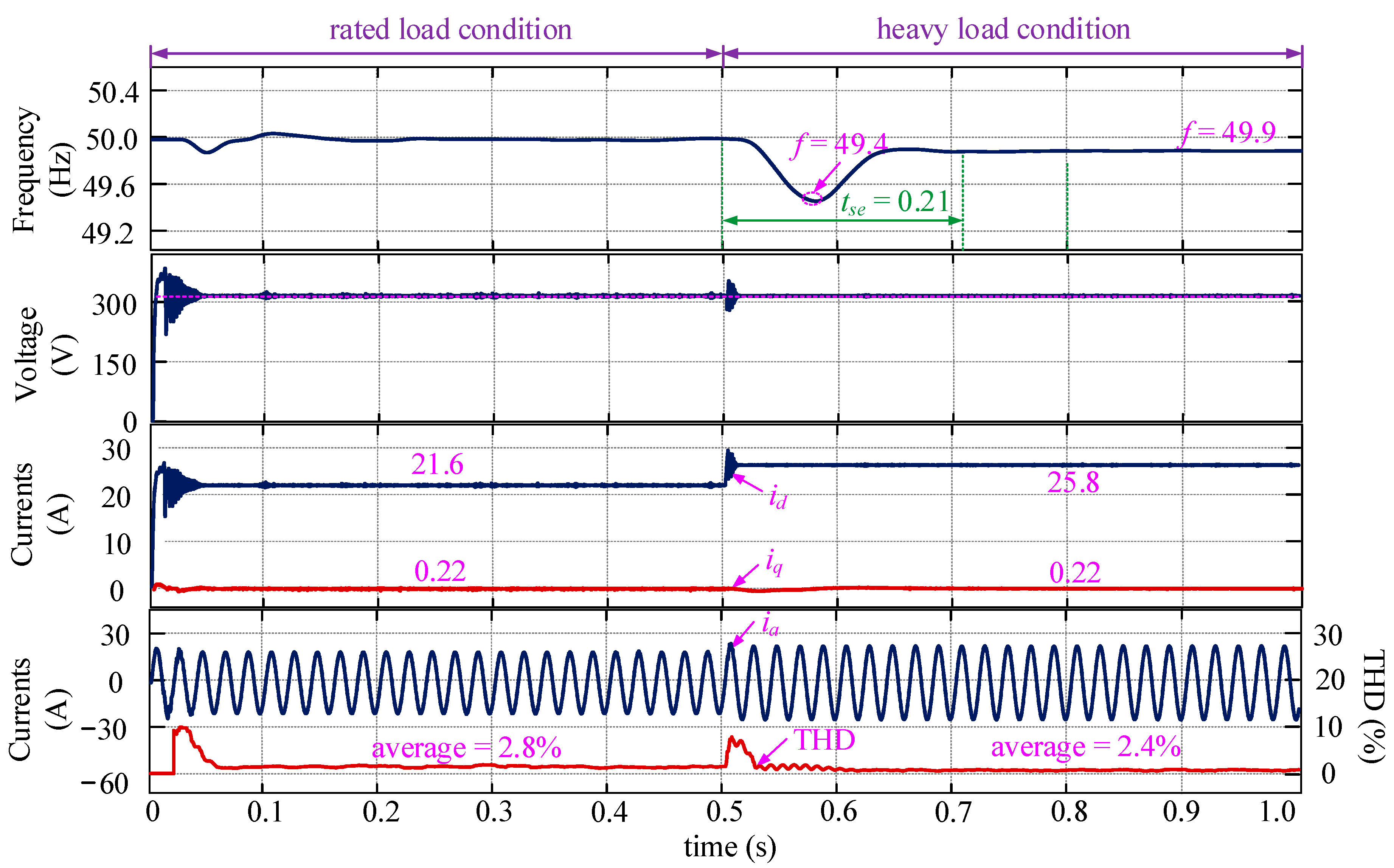
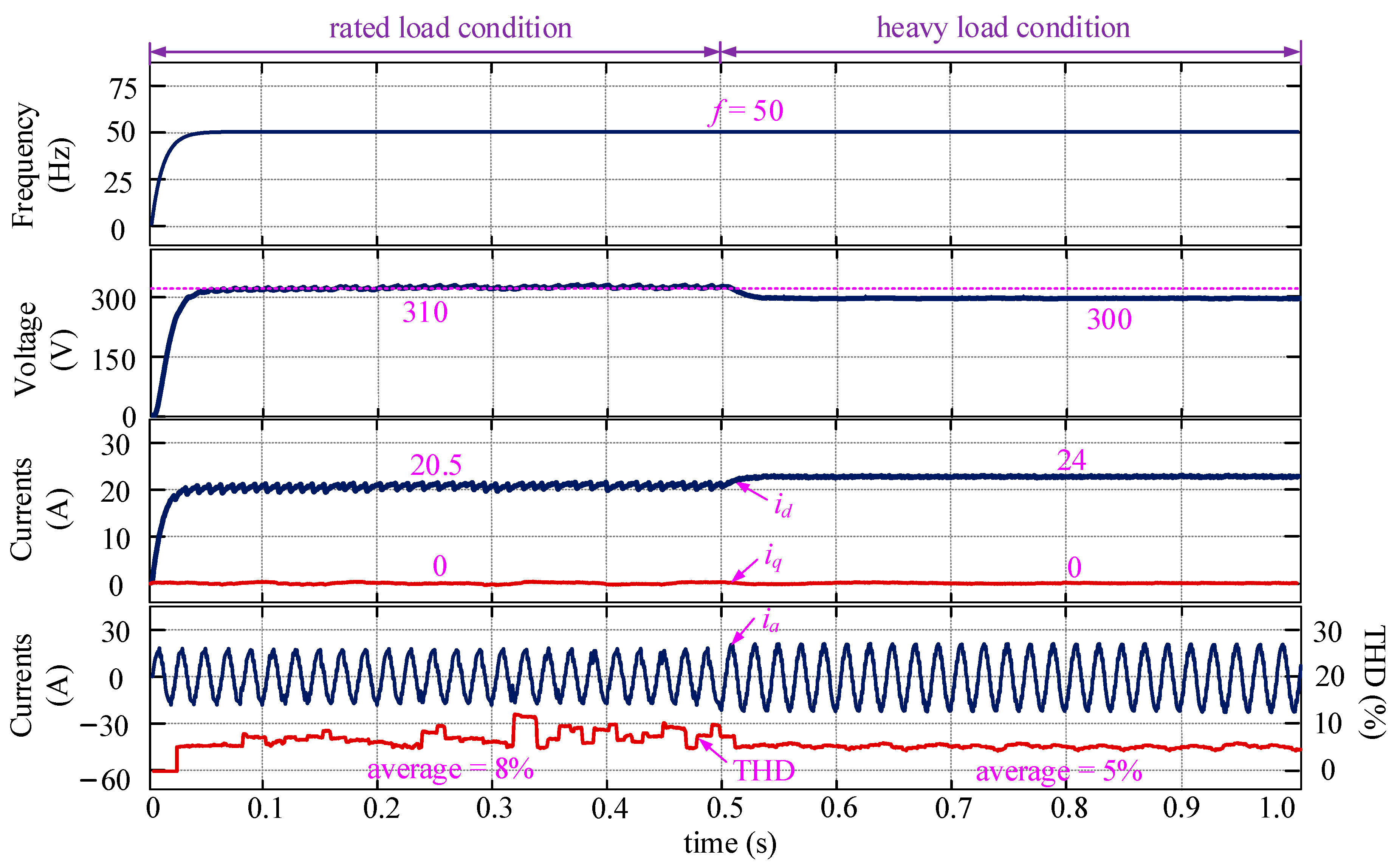
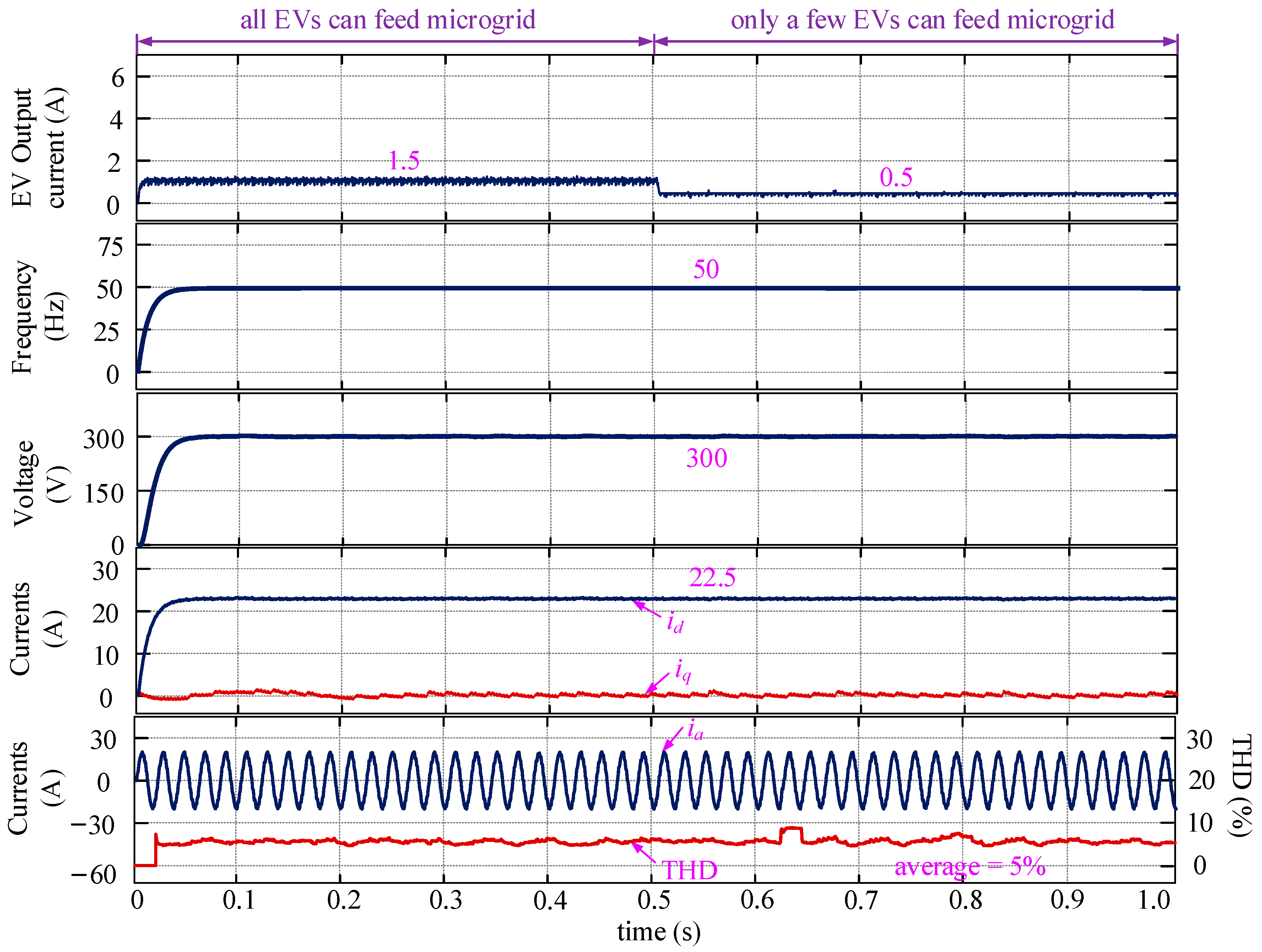
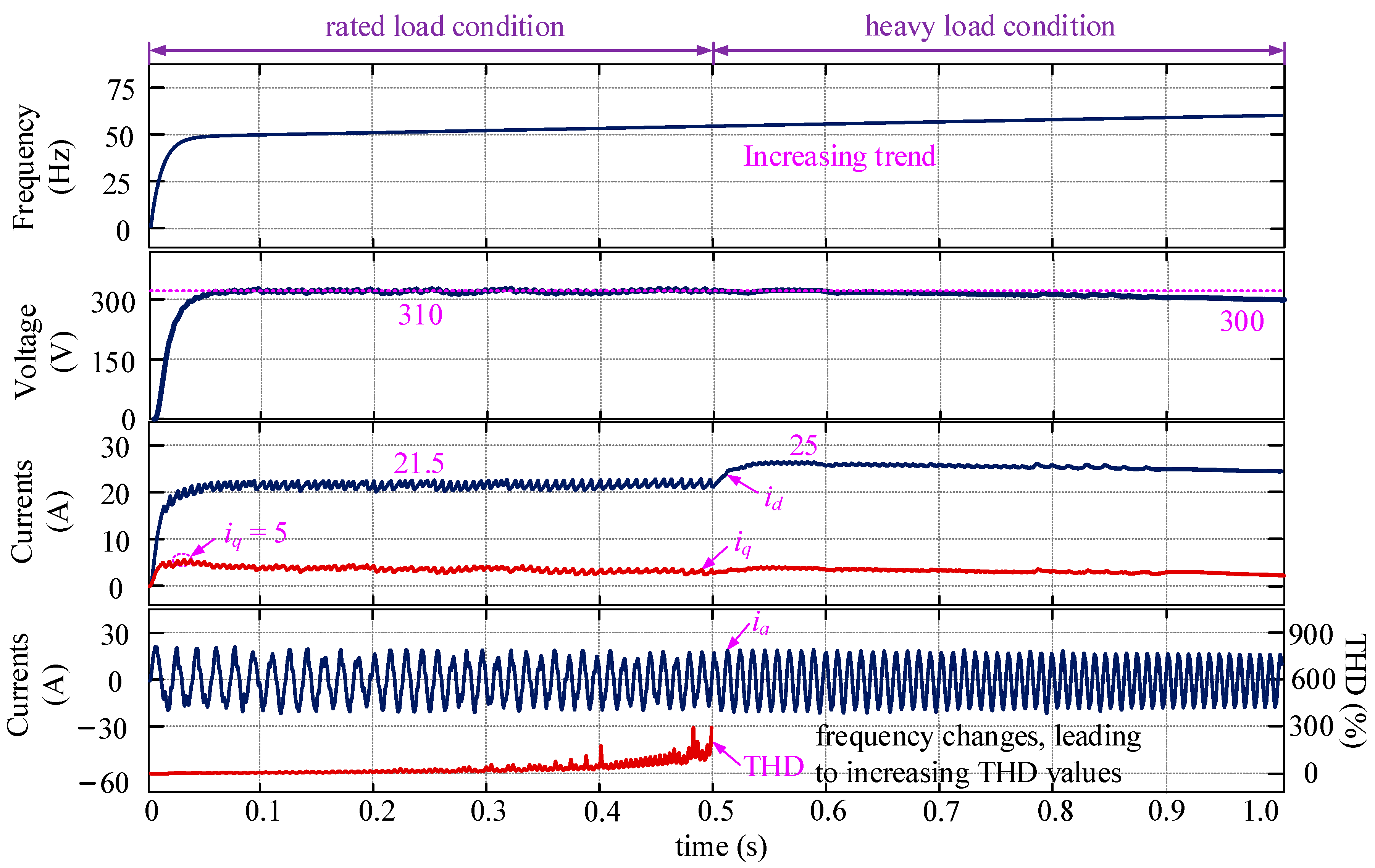
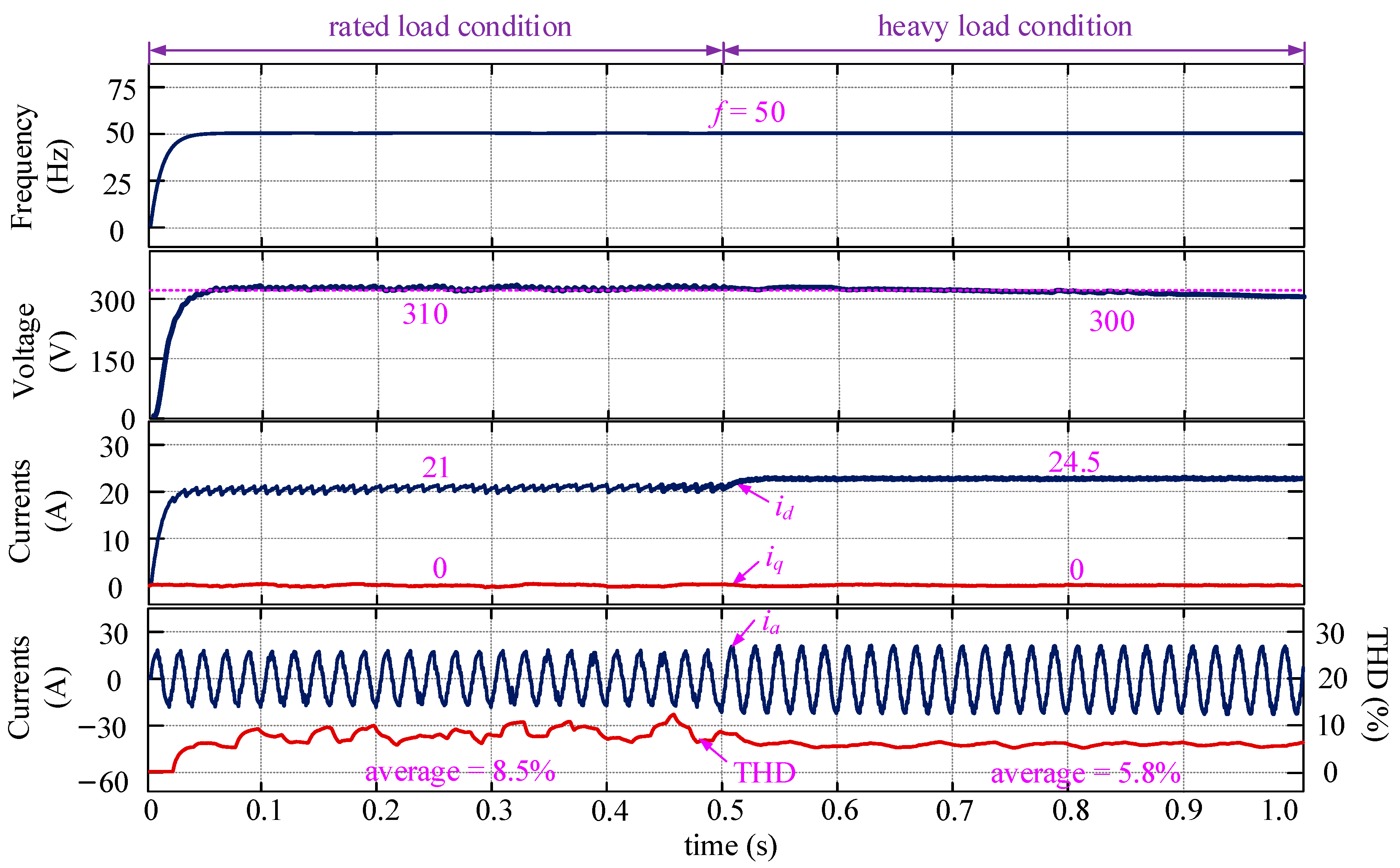




| Methods | Traditional VSG Strategy | Proposed DCL Strategy | |
|---|---|---|---|
| Differences | |||
| Regulated variables | active power and inactive power | frequency and voltage | |
| Voltage regulation | open-loop voltage control | voltage-errorless feedback control | |
| Frequency regulation | frequency-feedback-based power regulation | frequency-errorless feedback control | |
| Current control | X | MPC-based current regulation | |
| PWM signal generation | SPWM signal generation | optimal voltage vector selection-based PWM signal generation | |
| Variable | Value | Unit |
|---|---|---|
| PN | 10 | kVA |
| UN | 310 | V |
| fN | 50 | Hz |
| UDC | 800 | V |
| Lf | 0.18 | H |
| Rf | 0.16 | Ω |
| Cf | 10 | μF |
| Ll | 0.1 | mH |
| Rl | 1.2 | Ω |
| Ts | 0.001 | s |
| kω | −2π × 10−4 | - |
| kv | 0.0001 | - |
Publisher’s Note: MDPI stays neutral with regard to jurisdictional claims in published maps and institutional affiliations. |
© 2022 by the authors. Licensee MDPI, Basel, Switzerland. This article is an open access article distributed under the terms and conditions of the Creative Commons Attribution (CC BY) license (https://creativecommons.org/licenses/by/4.0/).
Share and Cite
Liang, Y.; He, Y.; Niu, Y. Robust Errorless-Control-Targeted Technique Based on MPC for Microgrid with Uncertain Electric Vehicle Energy Storage Systems. Energies 2022, 15, 1398. https://doi.org/10.3390/en15041398
Liang Y, He Y, Niu Y. Robust Errorless-Control-Targeted Technique Based on MPC for Microgrid with Uncertain Electric Vehicle Energy Storage Systems. Energies. 2022; 15(4):1398. https://doi.org/10.3390/en15041398
Chicago/Turabian StyleLiang, Yalin, Yuyao He, and Yun Niu. 2022. "Robust Errorless-Control-Targeted Technique Based on MPC for Microgrid with Uncertain Electric Vehicle Energy Storage Systems" Energies 15, no. 4: 1398. https://doi.org/10.3390/en15041398





